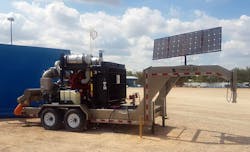The Cost and Safety Benefits of Automated Water Management
In the oil and gas industry, technological advances like hydraulic fracturing (fracking) and horizontal drilling have caused a boom in exploration and drilling. Initially, For most of its history, oil and gas development focused on people resources, as most work in the industry was done manually. Technicians and operators in the field checked all equipment and processes and manually adjusted and controlled whatever needed to be addressed. Even data required for environmental compliance was generally acquired by hand.
But today, with greater labor uncertainty and higher but volatile prices, investing in automation is starting to make more sense. As a result, companies are looking to add automation in the field, especially for water pumping and treatment—key ingredients in successful unconventional oil and natural gas production.
But automating assets located over a broad area isn’t easy.
Water, water, everywhere
Water is essential for successful natural gas production by fracking. The problem is that water sources are not often located near the drilling site. Therefore, pits are used to store water, blend water, handle flowback, and treat the used water.
“99% of jobs in the Permian Basin have water pits,” said Dan Arbeau, CEO of netDNA, a company that automates natural gas exploration and production, with a particular focus on drilling.
One of netDNA’s customers is New Wave Energy Services, which provides a range of fracking products and services in the U.S. and Canada, including water transport, modular tanks, and buffer tanks. New Wave offers large trailer-mounted units for water transfer, typically with four 500-800 hp pumps with 12-in. diameter inputs. It turned to netDNA for help in automating these units.
Arbeau had used Opto 22 SNAP PACs (programmable automation controllers) on previous jobs. He appreciated their reliability and use of open standards, such as Modbus/TCP, for easier communication with other systems and equipment. He had also heard about Opto 22’s new groov EPIC (edge programmable industrial controller), which provides additional communication, visualization, and security features for automation and industrial internet of things (IIoT) projects. The new EPIC controllers would be a good fit for the remote communications and mobile nature of these trailer-mounted units.
Each New Wave Energy trailer-mounted pumping unit includes a diesel generator and pumps controlled by a genset controller that talks Modbus/TCP. Arbeau added a groov EPIC processor and I/O modules on each trailer for additional automation, including:
· Analog inputs to monitor discharge levels and suction;
· Digital inputs to monitor flowmeters; and
· Mechanical relay outputs to open and close pumps via the genset controller.
In addition to the trailer-mounted units, netDNA also automates monitoring and control for the water pits and tanks.
Automating tanks improves safety as well as providing data faster, more easily, and more reliably. Tanks are monitored for levels, and pumps are controlled to make sure there are no spills. Tanks and pits are also monitored for air quality and hydrogen sulfide (H2S) levels. This is a critical safety concern as H2S is flammable and potentially deadly if inhaled.
At the pits and tanks, netDNA uses a SignalFire self-contained gateway for wireless sensors. This gateway uses Modbus/TCP to connect to a local groov EPIC processor. Each EPIC publishes a variety of data tags from its pumps using Node-RED and MQTT. Production data is also tracked and historized. If a spill or other issue occurs, producers need to know exactly what the pumps are doing at any given time.
“Some engine and pump companies are hungry for automation. Some have systems, but they don’t communicate with each other,” says Arbeau. “EPIC makes them talk.”
In addition to automated monitoring, control, and data acquisition, groov EPIC can deliver a custom web-based operator interface for authorized technicians. netDNA developed its interface using groov View, a tool included with the EPIC. The tool’s browser-based drag-drop-tag interface makes it simple to develop a custom HMI for PCs and mobile devices.
Each New Wave Energy trailer unit is also equipped with a radio IP (internet protocol) device that provides routing, 300 feet of wireless coverage, and power for a cell modem, which connects to the cellular WAN (wide area network). With the groov View HMI, authorized technicians in the field can use a tablet to connect to this network and run all 20 pumps in a system of pits—for example, to monitor or change RPMs—from a single screen.
Programming and data communications
The EPIC processor offers programming options, including flowchart-based PAC Control with optional scripting, IEC 61131-3 compliant languages, or C/C++, Java, and Python via Secure Shell access (SSH) to its Linux operating system. netDNA chose to use PAC Control with its free Modbus Integration Kit, which simplifies communications with the genset controllers and SignalFire sensor gateways.
For data communications, netDNA uses EPIC’s MQTT with Node-RED. MQTT is a publish-subscribe method of communication originally developed for the oil and gas industry, and it has huge advantages for remote or wireless networks. Each client initiates communication to a central broker/server and then publishes data, subscribes to data, or both. The broker/server does not store data, but simply accepts and forwards data packets as required. As a result, network traffic is reduced because data is communicated on a report-by-exception basis—that is, only when the data changes—rather than at regular intervals.
The EPICs used on each trailer, tank, or pit publish data to the MQTT broker, and other EPICs subscribe to the data. For their broker, netDNA uses its own hosted, secure MQTT server. Each EPIC device contains its own firewall for data security. The data the EPIC publishes is device-originated behind its firewall, so no inbound port modifications to the firewall need to be made. Once the EPIC makes the connection with the broker, any return data the EPIC subscribes to is received securely over the same connection.
The system works remarkably well for remote, wireless control. Multiple pumps respond to commands within a second. And to save bandwidth, netDNA sends data in tables instead of individual data points whenever possible.
With groov EPIC and modern IIoT tools at his disposal, Arbeau spent only three weeks from initial hardware design to having a full system ready for pump control. And thanks to netDNA, New Wave Energy Services can now offer its customers monitoring and control that’s faster and less expensive than competitors’ solutions.


